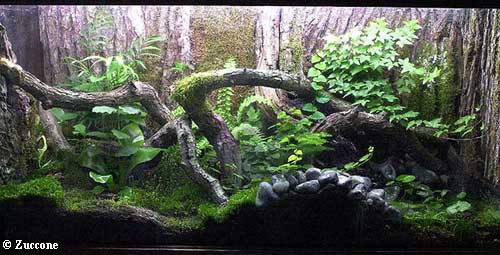Terrestrial Setups
Terrestrial Setup #13
 |
Dimensions: 120x40x50 cm; ~55 gallon Animals: adult Tylototriton shanjing Owner: Ester van Strien Comments: The swimming pool is 35x22x5 cm (14x9x2 inches). |
Terrestrial Setup #12
 |
Dimensions: 30x62x25 cm; 12x25x10 inches Animals: 5 young adult Ambystoma gracile Owner: Pamela Jordaan Comments: Normally, this is covered securely to prevent escape. |
Terrestrial Setup #11
 |
Dimensions: 120x45x30 cm; 45 gallons Animals: 4 adult tiger salamanders Owner: Mark Sobczak |
Terrestrial Setup #10
 |
Dimensions: 90x30x40 cm; 36x12x15 inches Animals: Fire salamanders Owner: Damian Money Comments: Substrate is top soil and peat mixture. |
Terrestrial Setup #9
 |
Dimensions: 90x30x40 cm; 36x12x15 inches Animals: Triturus marmoratus Owner: Damian Money Comments: Substrate is top soil and peat mixture. |
Terrestrial Setup #8
 |
Volume: 10 gallons Dimensions: 50x25x25 cm Animals: 3 juvenile fire salamanders Owner: Jennifer Macke Comments: The substrate is top soil topped with pillow moss and bark chips. |
Terrestrial Setup #7
 |
Dimensions: 100x50x50 cm; 40x20x20 inches Animals: 4 fire salamanders Owner: Zuccone Comments: The right corner is a small water area. Real bark is fixed to the back with polyurethane foam. |
Terrestrial Setup #6
 |
Dimensions: 40x40 cm; 16x16 inches Animals: 8 adult Triturus in the terrestrial phase Owner: Juraj Lezovic |
Terrestrial Setup #5
 |
Dimensions: 40x40 cm; 16x16 inches Animals: 5 juvenile fire salamanders (Salamandra) Owner: Juraj Lezovic Comments: Low plastic box. |
Terrestrial Setup #4
 |
Animals: Juvenile Triturus marmoratus Owner: Coen Deurloo Comments: This setup works well for feeding and monitoring small juveniles. In the back on the right you see a piece of apple to attract the fruitflies. |
Terrestrial Setup #3
 |
Dimensions: 3 shelves approx. 60x30 cm; 24x12 inches Owner: Heather Bjornebo Comments: This is a great way to save some space and provide room for your terrestrial caudates for a low cost. The substrate is 2 to 3 inches of tightly packed soil, kept moist, but not muddy. Hiding places should be provided. Water dishes are optional depending on whether the soil is kept at the right moisture level. Note that this setup is not recommended for smaller animals that may climb the sides and escape through cracks. It works well for Tylototriton shanjing. |
Terrestrial Setup #2
 |
Dimensions: 60x30x30 cm; 24x12x12 inches Animal: 1 tiger salamander Owner: Heather Bjornebo Comments: This setup simulates an underground habitat for fossorial amphibians like Ambystomids. It is a large underbed storage box containing 4 to 5 inches of moist packed soil. Air holes are melted into the sides with a hot glue gun. |
Terrestrial Setup #1
 |
Volume: 15 gallons Dimensions: 60x30x30 cm; 24x12x12 inches Animals: 16 efts of Notophthalmus viridescens dorsalis (broken striped newt) Owner: Jennifer Macke Comments: These efts are very small - you can see one in the front/center of the tank. The water dish is made from a frozen food bowl. The substrate consists of layers of: gravel, charcoal, dirt, bed-a-beast and terrarium moss. The efts usually stay hidden under the moss until I spray in water, then they come out and crawl around. |
For more setup photos, see Setting It Up.
